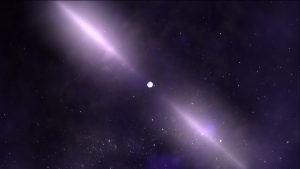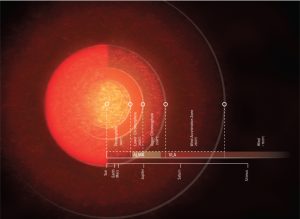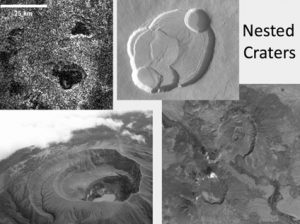Media
Transcript
One of the most remarkable things about astronomy is that we have the ability to understand things we can’t touch, measure, or otherwise experience up close. Here, from the surface of our pale blue dot, we can observe our universe and say, “Yes, I know how this formed”. We don’t know all the details, but our big picture understanding is capable of making remarkable predictions that prove true over and over again.
Sometimes though, our models for how objects work are remarkably vague. Consider the pulsar. These whirling blobs are a special kind of neutron star that appears to rotate tens to hundreds of times a second, and with each rotation, we see two pulses of radio light. First detected by Jocelyn Bell Burnell and her thesis advisor in 1967, the pulses have been described as bright spots or jets associated with the poles of the star’s magnetic field, which must not be aligned with the star’s rotational axis. The idea is, as the star rotates, the magnet poles come in and out of view, and it is only when they are pointed generally toward us that we see these pulses.

Why are there bright spots? Well, that part has been a bit of a mystery for many decades. Pulsars are weird objects. They aren’t really stars, but instead are the dense cores of former stars that blew off their atmospheres in supernova explosions, while their cores collapsed down so small that only neutrons can get close enough to exist. They are a kind of dense we can’t comprehend. They are “1.5 solar masses resting within the diameter of Manhattan Island” dense. They are “a tablespoon’s worth of mass weighs ten million tons” dense. They are “so dense that physics goes relativistic in a lot of cases” dense. Figuring out anything about these objects has been a challenge.
But now, one team has found a way to use physics to explain the bright magnetic poles of pulsars. In a paper appearing in Physical Review Letters, researchers describe how the interplay between magnetic and electric fields can drive what might be described as photon-producing lightning. Now, that is one heck of an oversimplification of work that is rich in detail. It is the detail in this work that makes it so interesting.
Here is what they think is happening: the neutron star’s massive magnetic field is tearing electrons from the star’s surface and accelerating them like a naturally occurring rail gun. This acceleration drives the release of gamma-ray energy photons that interact with the magnetic field to transform energy to matter, creating pairs of electrons and positrons. Initially, some of these particles are accelerated, leading to further pair-production. These newly coalesced particles eventually fill the region and dampen the electric field momentarily, creating an oscillation in the field, and we observe this oscillation as radio waves.
According to lead author Alexander Philippov: The process is a lot like lightning. Out of nowhere, you have a powerful discharge producing a cloud of electrons and positrons, and then, as an afterglow, there are electromagnetic waves.
This work takes advantage of modern computing technology. These are exceedingly complex systems, and past attempts to simulate what is going on could only follow a single line of points radiating up from the pole, and that one-dimensional kind of a model can’t simulate the electric fields that are so important in this result. In this paper, these researchers, who are part of New York’s Flatiron Institute, were able to create a two-dimensional model that cuts a plane through the magnetic pole and thus can follow some of the electric field phenomena. Now, we need to point out, the universe is three dimensional, and this two-dimensional model will be missing things. We won’t know how important those missing unknowns might be until we can do three-dimensional models. Luckily, this is a pretty symmetric kind of a system, so the model should be getting the big picture right, and this should be one more phenomenon that has gone from a vague explanation to a science-based explanation.
Science advances with our technology, both in how we are able to model objects in the Universe and in how we are able to observe them. Science also advances thanks to the creativity researchers employ in using both their models and their telescopes.
In a new paper in Astronomy & Astrophysics, an international team figured out they could use the combined observing capabilities of the Atacama Large Millimeter/submillimeter Array (ALMA) and Very Large Array (VLA) to observe the outer layers of the nearby massive star, Antares.

With our eyes and visible-light telescopes, we only see the star’s photosphere – the layer where light is released into a mostly transparent gas to begin its journey through the Universe. ALMA, working in the millimeter and sub-millimeter wavelengths of light, could see the chromosphere that is above the photosphere, and the VLA, working in even longer radio wavelengths, could map the even-more distant Wind Acceleration Zone. This allows us, for the first time, to see these outer star layers that we are used to only seeing surrounding our own nearby Sun and allows for amazing comparisons.
For instance, while our Sun’s chromosphere is only 1/200th of its radius at the photosphere, but they found Antares’ chromosphere extended 2.5 times the star’s radius away from the photosphere. They also found that Antares’ chromosphere is warm rather than exceedingly hot, coming in at a peak temperature of 3500℃ as compared to our Sun’s 20,000℃. These measurements will help us piece together relationships between stellar rotation rates, sizes, and other facets and the temperature profiles beyond the star’s photospheric surface. It’s a start at least, and for now, it is simply amazing that we can see the outer layers of other stars.
While space scientists use a lot of different kinds of data, image data is one of the best ways we have to study and compare other worlds. It is from orbiting satellites that we’ve learned to see our Earth and a myriad of rocky surfaces as often more similar than different.
Intriguingly, one of the most Earth-like geologies we see can be found on a distant moon of Saturn. The large moon Titan has a thick atmosphere, lakes of methane and ethane, and early images by the Huygens probe even spotted what appear to be river deltas on its surface. Now, we learn, volcanic craters with complex rims can also be found on Titan.

In a new paper appearing in the Journal of Geophysical Research, Planetary Science Institute’s Charles Wood and coauthor Jani Radebaugh of Brigham Young University used images from NASA’s Cassini spacecraft to make this discovery. The craters appear in Titan’s north polar region and may be associated with the massive lakes. According to Wood: The close association of the proposed volcanic craters with polar lakes is consistent with a volcanic origin through explosive eruptions followed by collapse, as either maars or calderas. The apparent freshness of some craters may mean that volcanism has been relatively recently active on Titan or even continues today.
Now, volcanism doesn’t mean there are massive lava flows or any of the magma related processes we’re used to here on Earth. These eruptions could be driven by methane, nitrogen, or some other volatile material. We can only hope that the future Dragonfly Mission can now plan to one day observe whatever these outbursts may be.
Speaking of planning to observe, if you are in central Africa, the Middle East, or southeast Asia, you have an annular eclipse coming up this weekend! Normally, I’d be advising you to plan to hop in your cars and drive somewhere to see this natural phenomenon, but these are plague times, so please stay home and stay safe. Eclipses aren’t that rare, and you’ll have another chance. Still, if you have a balcony or yard, it will be worth going outside to take a look. This will be a morning event for most, and you can find the exact times when the moon blocks the sun for your location at timeanddate.com. We’ll provide links on our website, DailySpace.org. If you’re not in the right place in the world to watch, or can’t safely go outside, don’t worry, we’ve got you. We’ll be providing live streams from community members Ambious and Gillian who are in Isreal and Pakistan, respectively. If you want to join the stream and have a prime eclipse viewing spot, please let us know on the CosmoQuest Discord.
Tomorrow we will be back with Rocket Roundup, but for now, this is all the science we’ve got.
Learn More
Why Pulsars Shine Bright: A Half-Century-Old Mystery Solved
- Simons Foundation news article
- “Origin of Pulsar Radio Emission,” Alexander Philippov, Andrey Timokhin, and Anatoly Spitkovsky, 2020 June 15, Physical Review Letters (Preprint on arxiv.org)
Supergiant Atmosphere of Antares Revealed by Radio Telescopes
- National Radio Astronomy Observatory news release
- “ALMA and VLA Reveal the Lukewarm Chromospheres of the Nearby Red Supergiants Antares and Betelgeuse,” E. O’Gorman et al., 2020 June 16, Astronomy & Astrophysics
Evidence for Volcanic Craters on Saturn’s Moon Titan
- Planetary Science Institute press release
- “Morphologic Evidence for Volcanic Craters near Titan’s North Polar Region,” Charles A. Wood and Jani Radebaugh, 2020 June 10, Journal of Geophysical Research: Planets
Credits
Written by Pamela Gay
Hosted by Pamela Gay
Audio and Video Editing by Ally Pelphrey
Content Editing by Beth Johnson
Intro and Outro music by Kevin MacLeod, https://incompetech.com/music/


 We record most shows live, on Twitch. Follow us today to get alerts when we go live.
We record most shows live, on Twitch. Follow us today to get alerts when we go live.